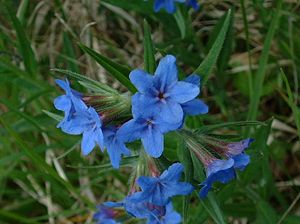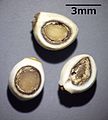Blue-red stone seeds
| Blue-red stone seeds | ||||||||||||
|---|---|---|---|---|---|---|---|---|---|---|---|---|

Blue-red stone seeds ( Aegonychon purpurocaeruleum ) |
||||||||||||
| Systematics | ||||||||||||
|
||||||||||||
| Scientific name | ||||||||||||
| Aegonychon purpurocaeruleum | ||||||||||||
| ( L. ) Holub |
The blue- red stone seed ( Aegonychon purpurocaeruleum , syn .: Buglossoides purpurocaerulea , Lithospermum purpurocaeruleum ), also known as the blue- red beef tongue or the purple- blue stone seed , is a species of the genus Aegonychon from the boraginaceae family. It used to be assigned to the genus stone seeds ( Lithospermum ) and then to beef tongues ( Buglossoides ).
The blue-red stone seed was Flower of the Year 2000.
description
The blue-red stone seed is an herbaceous plant that reaches heights of about 20 to 60 cm. The stems are arched and can form roots at their ends resting on the ground. The leaves are lanceolate with a clearly visible central rib on the underside.
The flowers are in a racemose inflorescence . The hermaphrodite, radially symmetrical flower has a diameter of 10 to 15 mm. The petals are fused tubular with a wide, funnel-shaped edge, with hairy stripes on the inside. It is red-violet when it blossoms, the color later changes into a deep blue (hence the name part "bluish red"). The flowering period extends from April to June.
The partial fruits have a white glossy smooth surface and are about 4 to 5 mm long. When the fruit is ripe, the calyx is 8 to 12 mm long. The hardness of the seed, which prevents it from breaking open, led to the generic name Steinsame.
The number of chromosomes is 2n = 16.
ecology
The blue-red stone seed is a deciduous hemicryptophyte . The flowers are long-tube "small funnel flowers" with 5 hairlines in an open throat, through which the pollinators' probes are led to the nectar . When they unfold, the flowers are purple-red, when opened they are deep blue. Pollinators are relatives of bees and bumblebees . Spontaneous self-pollination also occurs.
The flowering period is from April to June. The Klausen are rock-hard, spherical, smooth and shiny white. They spread as rolled fruits, are hardy and cold germs . The vegetative reproduction takes place through the later bending down, arched shoots, which form root tufts at the contact points, and through the rhizome .
distribution
The purple-blue stone seed occurs scattered, especially in the Pannonian area (sub-Mediterranean floral element). This lime-loving species thrives in warm, dry ( downy oak ) forests on the colline to submontane altitude level . It is endangered in the southeastern Alpine foothills. The distribution area includes southern, eastern and central Europe north to Belgium and Poland, as well as western Asia and the Caucasus.
In Germany, the blue-red stone seed occurs mainly in the heat-favored valley locations in southern Germany, such as B. Upper Rhine Plain , Main Franconian Plates , Nahe Valley. In the east of Germany the occurrence is limited to Thuringia and the south-west of Saxony-Anhalt.
The blue-red stone seed is a character species of the order of xerothermal mixed oak forests (Quercetalia pubescentis-petraeae) in Central Europe, but also occurs in societies of the Berberidion association or the Fagetalia order.
Toxicity and Use
The seeds are by pyrrolizidine - alkaloids slightly toxic. The blue-red stone seed is recommended as an ornamental plant for wild plant gardens and rock groups; however, it is very willing to spread. In the past it was also used as a medicinal herb against bladder and kidney problems.
photos
swell
- Characteristics.
- Ruprecht Düll , Herfried Kutzelnigg : Pocket dictionary of plants in Germany and neighboring countries. The most common Central European species in portrait. 7th, corrected and enlarged edition. Quelle & Meyer, Wiebelsheim 2011, ISBN 978-3-494-01424-1 .
Web links
- Blue-red stone seeds. In: FloraWeb.de.
- Blue-red stone seeds . In: BiolFlor, the database of biological-ecological characteristics of the flora of Germany.
- Buglossoides purpurocaerulea (L.) IM Johnst. In: Info Flora , the national data and information center for Swiss flora . Retrieved February 5, 2016.
- Thomas Meyer: Rindszunge data sheet with identification key and photos at Flora-de: Flora von Deutschland (old name of the website: Flowers in Swabia )
Individual evidence
- ↑ a b Entry at The Euro + Med PlantBase - the information resource for Euro-Mediterranean plant diversity
- ↑ L. Cecchi, A. Coppi, HH. Hilger, F. Selvi: Non-monophyly of Buglossoides (Boraginaceae: Lithospermeae): Phylogenetic and morphological evidence for the expansion of Glandora and reappraisal of Aegonychon . In: Taxon . tape 63 (5) , 2001, p. 1065 , doi : 10.12705 / 635.4 ( online ). Online ( Memento of the original from September 24, 2015 in the Internet Archive ) Info: The archive link was inserted automatically and has not yet been checked. Please check the original and archive link according to the instructions and then remove this notice.
- ↑ a b Erich Oberdorfer : Plant-sociological excursion flora for Germany and neighboring areas . With the collaboration of Angelika Schwabe and Theo Müller. 8th, heavily revised and expanded edition. Eugen Ulmer, Stuttgart (Hohenheim) 2001, ISBN 3-8001-3131-5 , pp. 779 .
- ^ Buglossoides in the Germplasm Resources Information Network (GRIN), USDA , ARS , National Genetic Resources Program. National Germplasm Resources Laboratory, Beltsville, Maryland. Retrieved July 19, 2020.




